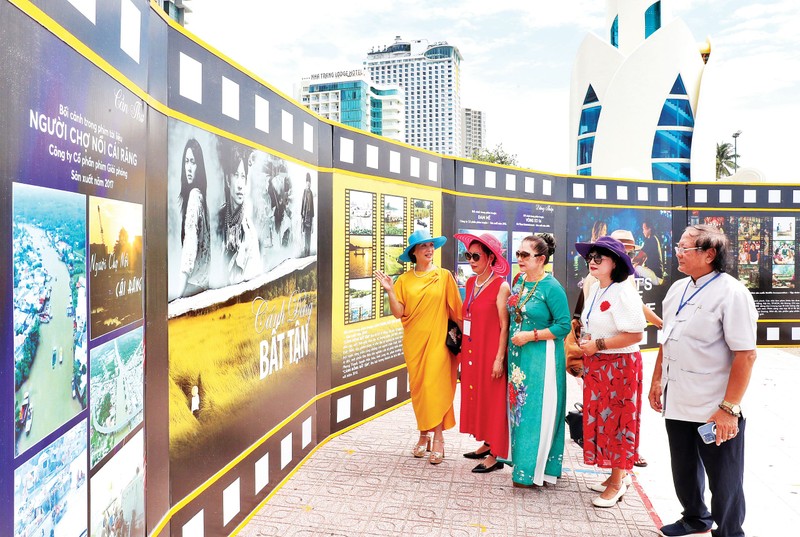Unfortunately, the results achieved thus far are still inversely proportional to that beautiful dream. And the journey to turn the S-shaped strip of land into an ideal destination to attract foreign filmmakers is still quite thorny, with a lot of work to be done.
Efforts to build bridges of connection
Promoting, introducing, and connecting potential scenes to domestic and foreign filmmaking teams is the unified effort of the country's film industry. From management agencies to numerous artists, from professional associations to all film event organisers, all are aiming for a common goal, building a bridge to bring the beauty of Vietnam to international friends.
Exhibitions introducing movie backgrounds and seminars discussing effective solutions are the two types of activities that take place, with the greatest frequency and most regularity, recording the most enthusiastic sharing in most national and international film festivals.
The latest examples are a photo exhibition introducing tourism through footage within the framework of the 2023 Golden Kite award in Khanh Hoa and an exhibition called "Da Lat - inspiring cinema" at the 23rd Vietnam Film Festival, which just took place in Lam Dong in November 2023.
The topic of how to take full advantage of the destination's advantages and potential to develop the local economy often appears, such as a cinema seminar on connecting and spreading cultural values at the 6th Hanoi International Film Festival held in November 2022 or the seminar “Developing the film industry – Building a favourable filmmaking environment in Da Nang" within the framework of the 1st Da Nang Asian Film Festival in November May 2023.
Through each activity, localities possessing strengths of heritages have also identified specific goals for this roadmap. “Thua Thien Hue has been gradually implementing the goal of developing cultural industries, with cinema being the key industry. As such, the province is implementing the goal of building Hue into a Vietnamese film studio," shared Dr. Phan Thanh Hai, Director of the Department of Culture and Sports of Thua Thien Hue province.
 |
Many localities such as Ninh Binh province have many advantages to develop cultural industries, including the film industry. Photo: Ministry of Culture, Sports and Tourism. |
Nguyen Manh Cuong, Director of the Department of Culture and Sports of Ninh Binh province also affirmed: "Ninh Binh has many advantages to develop cultural industries and creative cultural products based on heritage gold mines, including the film industry."
Helping film industry become profitable
For a long time, attracting international filmmakers has been considered a means to promote tourism and contribute to effective economic development in many countries.
Expedia's 2023 Travel Trends Report shows that globally, 66% of travellers have considered visiting a destination after seeing it featured in a show or movie they’ve streamed at home, and 39% have booked a trip for the same reason. As a result, many destinations now consider film as an important field in boosting the economy.
Film production brings economic benefits and jobs to many people.
Phan Cam Tu,
The Vietnam Association of Film Promotion and Development (VFDA).
However, according to statistics from the Department of Cinema, there are only 256 film production projects with foreign elements (including co-production films between Vietnam and foreign countries, foreign films choosing Vietnam to use production services and shoot scenes) during the past 10 years.
The most optimistic numbers belong to 2016 (with a total of 37 projects), 2019 (35 projects), and 2020 (30 projects). After the COVID-19 pandemic, the number of films entering Vietnam has decreased significantly, with a total of seven projects in 2021 and only two projects in the first half of 2023.
There are many reasons, but we are lacking the most important thing - preferential policies for film production.
According to Nguyen Phuong Hoa, Director General of the International Cooperation Department under Ministry of Culture, Sports and Tourism, a lack of preferential policies and simplified administrative procedures in attracting and supporting foreign film crews into Vietnam has put us at a disadvantage in competing with other countries in the region.
Meanwhile, the film powers have developed preferential policies in many diverse forms such as free filming sets, cash refunds for production costs, tax exemptions.
 |
The Quiet American is the first Hollywood film to portray the Vietnamese streets of the 1950s. (Photo: Nhan Dan Newspaper) |
However, the amended Cinema Law 2022 still only has a few short lines in Article 41 with the content "Foreign organisations producing films with the use of backgrounds in Vietnam or film production services provided by Vietnamese organizations may receive tax incentives according to laws on tax.".
The film "Pan" has some scenes filmed in Quang Ninh and Ninh Binh. Photo: Nhan Dan Newspaper
From the perspective of many experts, to invite international film crews to Vietnam, a series of policies and solutions are waiting to be planned and implemented quickly.
 |
A scene taken in Ha Long for the movie Indochine directed by Régis Wargnier. (Photo: Nhan Dan Newspaper) |
Not stopping at tax incentives alone, it is also necessary to apply other financial incentives such as free use of filming locations and parking lots; cutting down on cumbersome and unnecessary administrative procedures; and publicising and specifying information about the process and procedures for applying for licenses.
In addition, the establishment of a specialized agency in each locality such as the film office to support the management and promotion of film production, similar to the current model that the US and Singapore are applying, is also a positive suggestion.
During a workshop on Asian Cinema Project, producer Michael Lake once affirmed that American cinema currently tends to choose to shoot pre-production in Asia, instead of 60% in the US as before. Thus, if there were appropriate incentive policies and a team of high-quality, international-standard human resources, Vietnam would definitely become the top choice.
 |
Kong: Skull Island is the first Hollywood blockbuster shot in Vietnam (Photo: Nhan Dan Newspaper) |
















